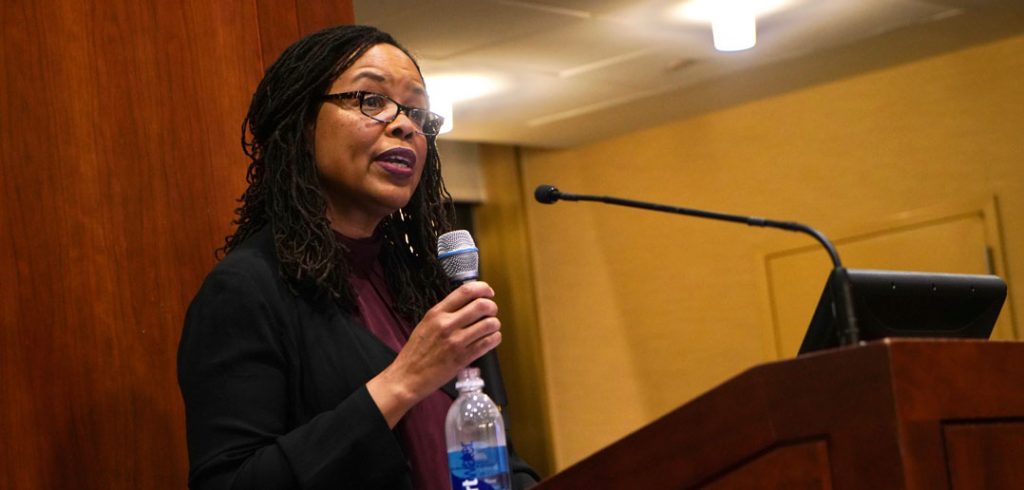Those were the opening words of this year’s annual Black History Month lecture delivered by Saidiya Hartman, Ph.D., professor of English and comparative literature at Columbia University, at the Lincoln Center campus on Feb. 21.
Jim and Julia
Hartman was reflecting on a short science fiction story by W.E.B. Du Bois and its implications on white supremacy as she began her talk, titled “Wild Thoughts and Rumors about the Auspicious Era of Extensive Freedom, or A Speculative History of the Demise of White Supremacy.”
The words described Jim Davis, a black bank messenger, in Du Bois’ short story, The Comet. In Jim’s world, society is still segregated by race. After a comet hits New York and expels toxic gases that seem to have killed everyone around him, Jim finds a wealthy white woman named Julia. Thinking that they are the only humans left in the world, they start to connect and see past the color of each other’s skin. But at the end of the story, they discover there are more survivors. Julia’s father and fiancé find her, and she leaves Jim to join them, while an unnamed black woman holding a baby’s corpse falls into Jim’s embrace.
To Hartman, a 2019 recipient of the MacArthur “genius” grant, The Comet is Du Bois’ attempt to explore the possibility of overturning white supremacy in a post-apocalyptic world. It’s a “tale about interracial love—less what happened to it than a question or doubt about the circumstances in which it might be possible or permitted,” she said.
“One of the things you see in Du Bois is always attempting to imagine what’s going to allow an opening for a new arrangement to emerge or for abolition and democracy to in fact be realized,” Hartman said in Lowenstein’s 12th-floor lounge to an audience of roughly 100 guests, the majority of them students.
Du Bois, a leading scholar and civil rights activist in the first half of the 20th century, wrote The Comet—an example of speculative fiction focused on black society—“in the hope that I may strike here and there a half-tone, newer even if slighter, up from the heart of my problem and the problems of my people,” he wrote in the story’s postscript. The story, part of Du Bois’ book Darkwater: Voices from Within the Veil, is an old tale published in 1920, but its themes still resonate in modern media, Hartman said
“For those of you tempted to dismiss Du Bois and the comet as antiquated, as a variant of Guess Who’s Coming to Dinner, staged against the backdrop of climate catastrophe, I would encourage you to keep in mind contemporary films like Get Out or Bird Box, which also speculate about post-racial futures and end-of-the-world scenarios at the site of interracial love and intimacy,” Hartman said. “The coupling of black men and white women raises the question and possibility of a new race of people, in terms that might redress racial subjection and sexual violence, rather than reproduce it.”
‘The Crime That Du Bois Swears Can Never Be Pardoned’
At the end of the story, white supremacy continues to reign. In this world, “the white world, the world of man,” it is the black woman who has suffered the most, said Hartman.
“The history of insult and degradation, Du Bois notes, weighs most heavily on her shoulders. Her maternity is negated and exploited as a vehicle for the production of capital,” Hartman said. “She lives or dies at the white man’s whim and pleasure, a sentient tool and a property for enjoyment in every way imaginable. The harm the world has done to her has been so great and its violence so unrelenting, so seemingly irreparable, that it is the crime that Du Bois swears can never be pardoned.”
She recalled the mysterious black woman carrying a dead infant at the end of The Comet.
“The damage done to the black’s reputation as human is most severe in her case. Given this, it is not surprising that she is unable to secure a place in the world for her children, or make this unlivable state habitable for the ones she loves, or create minimal conditions for survival, or ensure her future or anyone else’s,” Hartman said.
Midway through the lecture, she looked up from her notes and scanned the audience.
“I know this is all very heavy,” Hartman said. “But it is timely.”
A Lesson on White Supremacy
In the final moments of her lecture, Hartman reflected on white supremacy in the past and present, in a commentary that intertwined Du Bois’ thoughts with her own.
White workers and ex-slaves shared a common enemy: plantation owners and northern industrial capital, Hartman said. But that commonality failed to lead to interracial solidarity or retaliation. The white working class cared more about “the processes of racial enchantment and the possessive investment in whiteness.” They identified more with their white masters and rulers, she said, although they were separated by socioeconomic status.
“This irrational and deep psychic investment in whiteness prevented—and we might add, continues to prevent—any recognition of a shared state or partial commonness with black people,” Hartman said.
The lecture was sponsored by the Department of African & African American Studies, the Office of the Chief Diversity Officer; the Center on Race, Law and Justice; Department of Communication and Media Studies; Department of English; Comparative Literature Program; and Women, Gender, and Sexuality Studies Program. The event was also part of the Women of Color Initiative at Fordham launched in 2018, which encourages women of color to engage in conversation with one another.


